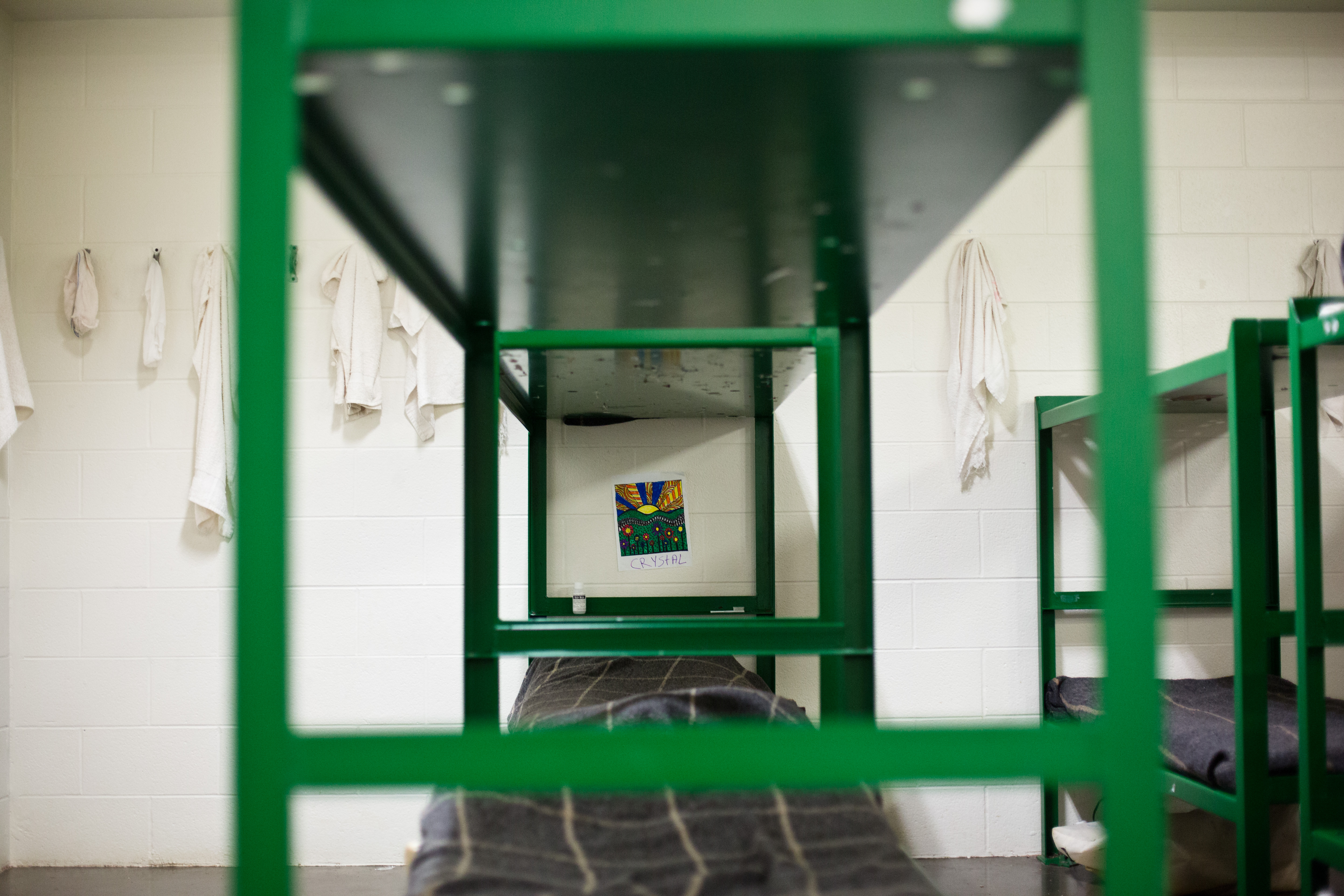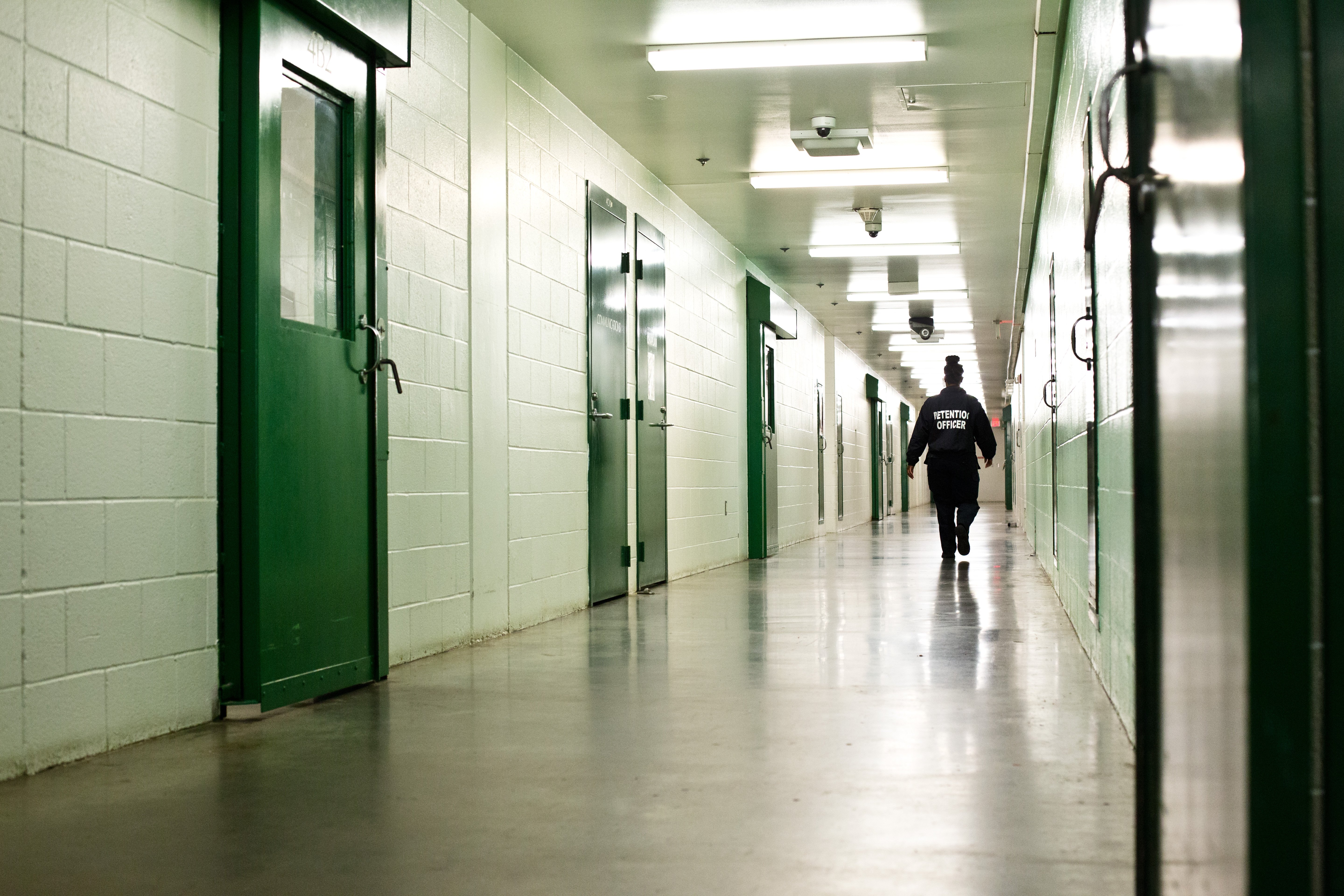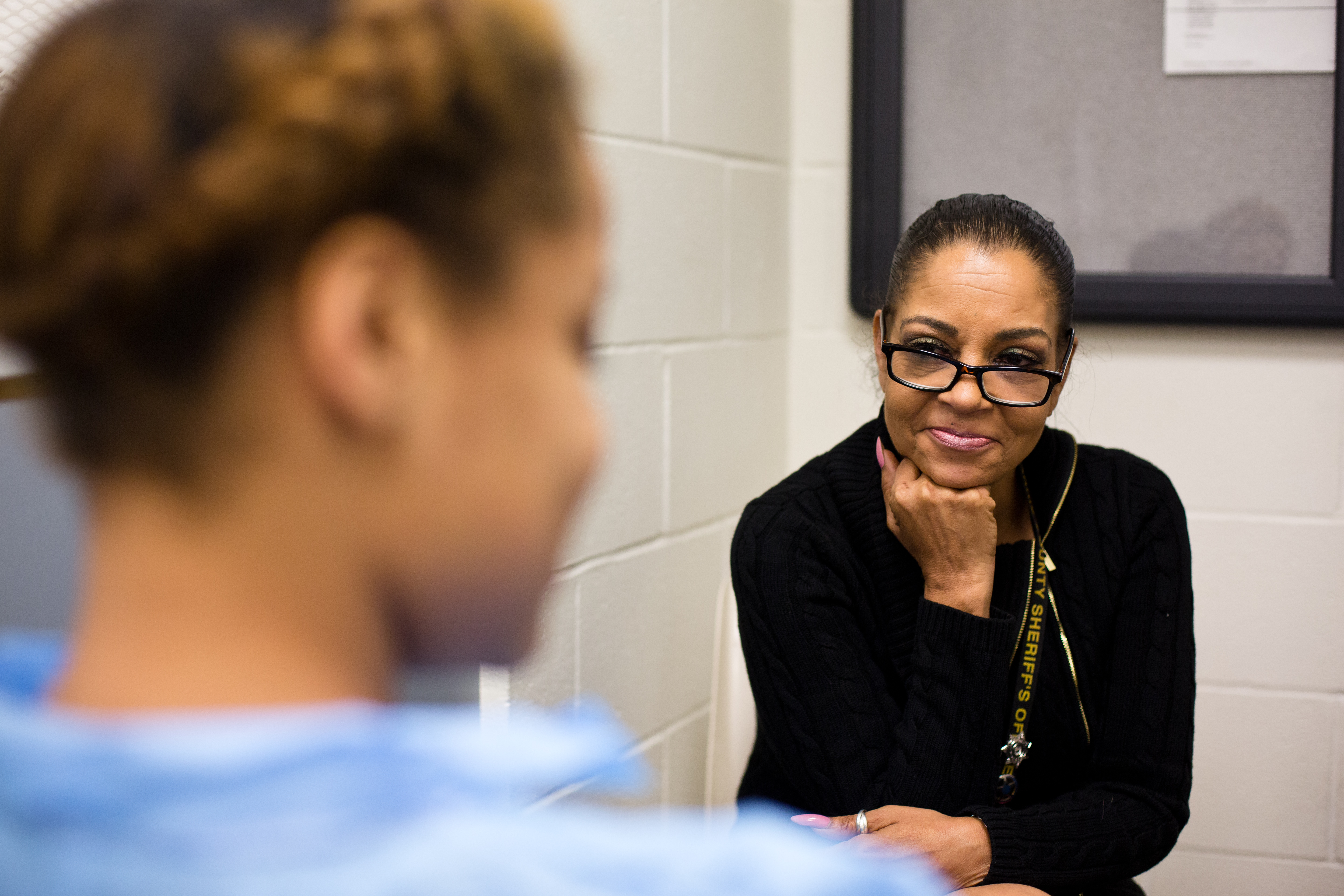Texas couldn’t help this sex-trafficked teen, so authorities sent her to jail
/https://static.texastribune.org/media/images/2017/02/08/Lena-LEAD-CCR_8463.JPG)


How the crusade against sex trafficking in Texas has left child victims behind.
HOUSTON — For three months in the fall of 2016, Lena was one of the youngest inmates in the Harris County Jail.
The 17-year-old lived with two dozen women in a single room. She slept on a metal bunk and wore an oversized orange jumpsuit every day. She went to the bathroom with no privacy, using a toilet attached to the wall.
Yet compared to what she'd endured, it didn't seem half bad.
Lena had felt trapped her whole life. At home, by an abusive adoptive mother. At school, where she wore turtlenecks and baggy clothes to hide her bruises. In one facility for foster kids after another after her mother lost custody of her. And by a series of pimps who sold her for sex after she ran away.
It was no surprise to Lena when she ended up behind bars for offering an undercover police officer oral sex in exchange for money.
"I always wanted older men's attention ... I got addicted to it," Lena said. "And the only way I knew how to get it was to lay on my back."
No one wanted Lena in jail — not the Houston police who arrested her, not the district attorney who pursued the case. In their eyes, she was not a prostitute; she was a child who had been sexually exploited and needed protection and care.
Lena and teenage victims like her end up in jail for one simple reason: There's nowhere else for them to go.
Texas has just one facility devoted to child sex-trafficking victims, called Freedom Place. It can only afford to treat 20 girls at any given time, and it won't accept kids who've been picked up by police in the middle of the night.
Other residential treatment centers in the state provide specialized care for foster kids who may have behavioral and emotional problems. But they aren't equipped to treat the type of trauma sex-trafficking victims have been through. They're also hesitant to take chronic runaways; Lena had fled such facilities several times before.
So authorities in Harris County and other big Texas counties who encounter kids like Lena take a gamble they call "arrest and recovery": arrest them to get them off the street and drop the charges later.
"What options do we have with these girls?" asked Ana Martinez, a prosecutor in Harris County who specializes in trafficking cases. "If I dismiss her case, she's just walking on the street that night."

Female inmates at the Harris County Jail who are part of a program for women involved in prostitution are all placed in the same room. Callie Richmond for The Texas Tribune
Lena agreed. She was fed up with foster care, fed up with running and fed up with the men who'd used her.
Getting arrested, she said, might just be the best thing that ever happened to her.

Lena was 13 when she ran away from her first residential treatment center, in a suburb of Houston. She was restless. She'd been there for nearly a year with no sign of a more stable solution. Most foster families didn’t want to take in a teenager with a checkered past.
Lena bolted from the front lawn of her Houston middle school one morning. Minutes later, as she walked down the street, she ran into a friendly-looking stranger. He promised to take care of her if she made him a little money.
His offer wasn’t unthinkable. She'd had sex before, and had been sexually abused, a factor that makes kids far more likely to fall victim to pimps. He promised her Ecstasy so she could focus on something else while she was having sex with johns.
Here was an adult who said he could protect her.
The Texas Tribune thanks its sponsors. Become one.
"Every time a man told me, 'I love you, I'm gonna take care of you,' I listened," Lena said. "I did everything they wanted me to do."
Lena stayed in the man's apartment in Greenspoint, a North Houston neighborhood, along with a few other women he also pimped out. One room was reserved for having sex with clients, whom the pimp solicited from truck stops and convenience stores.
Lena said she made $100 or $150 for every trick. She gave all her money to the pimp.
Over the next three years, Lena would have as many pimps. She'd stay with them for a few weeks or months, sometimes moving from motel to motel. Then she'd get scared or decide it was time to move, and return to foster care — then run away again.
Sometimes she felt free and wanted and independent. She took Facebook selfies in front of a bathroom mirror wearing a short black dress and big hoop earrings. She posted pictures of her pimps, shirtless and heavily tattooed, with captions like "I LOVE MY DADDY" and "My daddy loves me."
Other times, she felt miserable. Not long after her 16th birthday, she posted another selfie, lying on a bed, her face expressionless. "Fucked up on Molly's," she wrote, referring to Ecstasy. "Makin' money."
Later, she wrote: "My life is so fucked up I don't know what to do anymore."
Eventually, Lena's Facebook page went dark. Police had responded to an Internet post advertising sex with her and found her in a motel room. They arrested her pimp at the motel next door.
With Lena's help, police ultimately charged two people with forcing a child into prostitution. But the question remained: What to do with Lena?
Police knew she was a long-term foster kid and a chronic runaway. They also knew she needed serious help. A medical examination revealed she was pregnant and had three sexually transmitted diseases. She would need months of specialized psychological and medical care.
But she couldn't get any of it if she didn't stay put.
So Houston police charged the pregnant, 16-year-old sex-trafficking victim with a crime — she says it was prostitution, though juvenile records are not public — and sent her to juvenile detention.

Sex-trafficking experts and victims' advocates agree that Lena didn't belong behind bars.
"We're looking at this population in a different way," said Angela Goodwin, a top official at Texas' child welfare agency, the Department of Family and Protective Services. "We don't want to lock them up."
But across the state, the agency is facing a crisis when it comes to finding beds for kids like Lena — both when they're most susceptible to becoming trafficking victims and after they've escaped the hands of pimps.
Texas relies on private contractors to build and run treatment facilities for kids — and pays them very little money to do so. Those companies are then left to operate the facilities at a very low cost or raise money through donations. Few are willing to get into such a high-liability business, and many that do are reluctant to take kids with drug addictions or other particularly challenging behavioral problems.
The average cost of housing a high-needs child in a residential treatment center in Texas is about $300 each day. Right now, the state will only pay $260. Running a facility that is licensed to treat sex-trafficking victims is even more expensive; Texas law requires additional services, but the state doesn't pay for them.
Texas child welfare officials have told the Legislature it will take an additional $200 million to pay the full cost of housing children in the state's care. So far, state lawmakers have not committed to paying for any of it.
Meanwhile, existing facilities meant for the most troubled foster kids are shutting their doors. In the last year and a half, Texas lost more than 300 of these beds and is scrambling to replace them. As a result, kids in the state's care are routinely stuck in psychiatric hospitals or sleep on cots in their caseworkers' offices. Some are even forced to overstay their sentences in juvenile detention — which happened to 16-year-old Lena while she was pregnant, she said.
State officials say they're trying to find better solutions, both for vulnerable kids in the state's long-term foster care system and for those who have already been trafficked.
Gov. Greg Abbott recently announced that $8 million in federal grant money will soon become available to help some of the state’s most troubled long-term foster kids — paying for anything from specialized therapy to medical care.
Officials in his office say they also have millions of dollars in federal criminal justice money that organizations that serve child victims of sexual exploitation can apply for. They said they still don't know how much of that money they will distribute.
A year ago, Abbott formed a child sex-trafficking unit that will open offices in regions across Texas. The unit, designed to help with victim recovery, has a two-year budget of about $6 million in state money to distribute to organizations that provide victims’ services.
But none of those initiatives solve the capacity problem.
Private-sector plans are in the works to build the kind of place that Lena needed. The Alamo Youth Center in San Antonio hopes to be the first-ever facility to take sex-trafficking victims in emergency situations, stabilizing them before they're ready for longer-term treatment. But it will require $30 million in fundraising.

The Harris County Jail houses more than 8,000 inmates at any given time. For three months last year, 17-year-old Lena was one of them. Callie Richmond for The Texas Tribune
For now, the fact remains: While so many child sex-trafficking victims have some connection to the Texas child welfare system, that system has almost no resources to help them. Only the criminal justice system does — and sparingly.
In Harris County, for example, one innovative diversion court pays to house and care for juvenile trafficking victims. It has the funds to help about two dozen kids at any time, and a long waiting list.
Angela Ellis, the judge who presides over the court, struggles with the fact that kids can only benefit from her program if they're charged with a crime and locked up.
"How do you convince a kid that they're a victim when they're in a jumpsuit and they're shackled?" she asked.

Lena was released from juvenile detention just a few weeks before giving birth to a baby boy. She was sent to a residential treatment center outside of Houston.
Lena still had a lot of trauma to deal with, but she was excited to be a mother. Among the countless pictures she posted on Facebook over the past four years, the ones with her baby in the hospital are the few in which she's smiling.
But soon after she delivered her son, the state took custody of him. Out of grief and frustration, Lena ran.
The Texas Tribune thanks its sponsors. Become one.
"I completely gave up," she said. "My mind was still stuck in the streets. All I knew was the streets."
When police arrested her for prostitution a few months later, in the fall of 2016, she had nothing to her name but $50 cash and the crop top and jeans she was wearing.
She was now 17 — old enough to be charged as an adult.
At first, Lena was devastated. But her three-month stint at the Harris County Jail gave her time to think and a chance to participate in a county program for women facing prostitution charges. The women, most of them much older than Lena, shared stories of abuse at the hands of boyfriends, dads, grandfathers. They spoke of drug addiction and homelessness. They talked about how to live better lives on the outside. They became confidants for her; they braided her hair. She kept a journal.
Kathy Griffin, the program's director, said she was amazed at how much progress Lena made in such a short time. Of all of the young girls she'd met through the program, she said, Lena had one of the best chances of making it.
"She knows she's got a shot at having a real life," Griffin said.

Kathy Griffin, who runs a program for women involved in prostitution, became a mentor to 17-year-old Lena while the teen was in the Harris County Jail. Callie Richmond for The Texas Tribune
But there was a lingering question in Griffin's mind, one that had plagued Lena's care from the beginning: Where would she go next?
Lena was still 17, still in the state's care, and with no place to go. No foster family or residential treatment center had a bed for her. Her caseworker was going to drive her from jail to a 24-hour intake center for foster kids in West Houston, where she’d spend the night on a cot.
She had stayed at that intake center before, though, and she'd run away from it before.
Lena vowed things would be different this time. She promised she would stay put until she turned 18, just a few weeks away. With Griffin's help, she'd get accepted to a private nonprofit shelter for young adults in need.
She had a plan. She wanted to finish high school, go to Prairie View A&M University and study forensic science.
"You've got to want to change," Lena said as she left the Harris County Jail on a rainy Friday afternoon. "The test starts when you walk outside. And this is my test."
Lena’s caseworker took her to Church’s Chicken for dinner, then to the intake center. When they arrived, Lena went to take a shower and her caseworker left.
At 9:50 p.m., Lena walked out. Griffin and her caseworker haven’t heard from her since.

Intake centers like the one in West Houston are a last resort for foster kids. All they have to offer are cots, showers and warm meals; had Lena stayed there, she would have had to sit in her caseworker’s office during the day. Security staff can monitor who comes in, but they can’t stop anyone from leaving.
Texas child welfare officials know these intake centers are a terrible place for kids who have been through trauma.
"We are working with what we have. I'm not trying to be flip; I don't know any other way to put that," said Goodwin, the official at Texas’ child welfare agency. "Our workers can't handcuff them, they can't chain them, they can't tackle them."
But even after Lena ran away, state caseworkers and investigators didn't appear to make much effort to find her.
No one seemed to notice Lena's Facebook page, where she left a string of clues. Selfies in hotel rooms. Comments that named roads and neighborhoods. She even invited friends to come see her dance at a strip club in Houston, including the time of the show and the name of the club.
Organizations like the National Center for Missing and Exploited Children are experts at analyzing kids' online presence to help locate them. But Lena was never reported to the center after she went missing — a violation of federal law.
State officials say they reported 82 percent of all foster care runaways to the center in the last fiscal year. But investigators didn’t properly record data for about half of all kids who ran away during that time, so there is no way to confirm the percentage is actually that high.
Goodwin said she's "pretty happy" with the state’s performance so far, and added that it will improve as staffers get more experience and training.
By state standards, Lena's caseworker was quite experienced: She'd worked for the agency for five years.
In late December 2016, Lena turned 18 and aged out of foster care. She posted a selfie on Facebook wearing an elegant white dress, with blown-out hair and shiny red fingernails.
Griffin still hopes that one day, she'll hear from her. In the meantime, she wishes child welfare workers had made a different plan for Lena's release from jail — one that might have enticed her to stay put instead of making it so easy for her to walk away.
"I just don't trust these people with these kids," Griffin said. "And that's been a problem for a very long time."
About this story:
The Texas Tribune generally does not publish the names of victims of sexual abuse or sex trafficking. Lena is identified by her middle name at her request. The details in Lena’s story come from phone and in-person interviews with her, as well as from court documents and interviews with her lawyer, foster care caseworker, a family member, Harris County prosecutors, and other social workers and advocates familiar with her story. The Tribune also interviewed her pimp’s lawyer and one of her pimp’s associates.
Editor's note:
One of the reporters, Neena Satija, also works for Reveal, a public radio show and podcast from The Center for Investigative Reporting and PRX. Ryan Murphy was the lead developer on this story; Emily Albracht was the lead designer.
Information about the authors
Learn about The Texas Tribune’s policies, including our partnership with The Trust Project to increase transparency in news.
/https://static.texastribune.org/media/profiles/Morgan.jpg)
/https://static.texastribune.org/media/profiles/Edgar_GpkYiWm.jpg)
/https://static.texastribune.org/media/profiles/Neena_1.jpg)